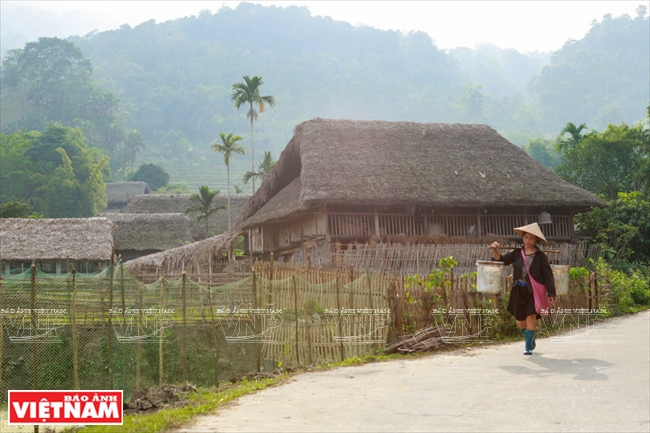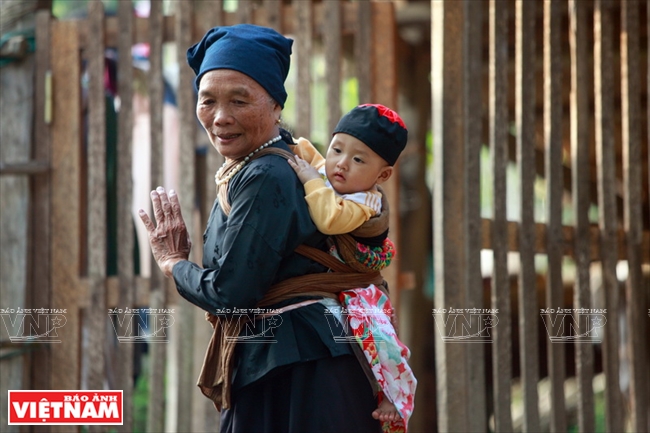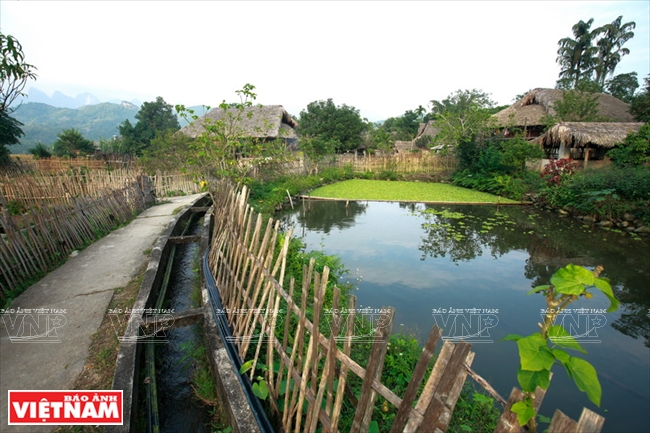Suoi Tien stream is filled with water all year round so it is used for watering the fields and supplying water for the inhabitants. People build fish raising ponds simply by dredging mud from the stream bed and building banks with rocks to keep fish inside. The fish raised by the Tay people in Phuong Do commune are called “bong” fish, which is suitable to the local climate and can provide a good income for the locals.
Nguyen Van Quyen, Tha hamlet tourism manager, regretted that we had not arrived a month earlier because we would have had the chance to witness the busy harvest of the Tay. After stepping inside the hamlet, we were amazed by the thatched roof houses on stilts built like a chess board and the friendly smiles of the hamlet residents.
 A corner of Tha hamlet from the mid- mountainside. Tha hamlet has more than 100 thatched roof houses on stilts on a flat land area in Phuong Do commune. Photo: Viet Cuong.  A typical wood house on stilts of the Tay in Tha hamlet, with a palm-leaf roof and fish pond. Photo: Thong Thien  Tha and Ha Thanh hamlets in Phuong Do commune have nearly 200 stilt houses built in the traditional style of the Tay. Photo: Viet Cuong  Inside a traditional stilt house with a palm leaf roof of the Tay in Tha hamlet. Photo: Viet Cuong  Utensils used by the Tay include creels and cages that are hung on stilt houses. Photo: Viet Cuong  “Con” balls are hung in front of stilt house verandas in Tha and Ha Thanh hamlets. In Tay culture, “Con” is not merely a toy in festivals but also an object symbolising abundance and fertility. Photo: Thong Thien  A peaceful afternoon in Tha hamlet. Photo: Viet Cuong  Besides scenic places in Tha and Ha Thanh hamlets, visitors see the quiet and gentle living space of a local inhabitant. Photo: Viet Cuong |
We stop at Nguyen Duc Thin’s house for a short rest and a drink. His large five room stilt house was built about a hundred years ago with common wood but still stands strong. “The Tay people in our hamlet selected this land to settle on. From my father’ time to now, this house has, so far, had its roof replaced five times,” he explained to us, adding that the stilt houses here are roofed with palm leaves, 20- 40cm thick, and last for 5 to 10 years.
| In Ha Thanh hamlet, there are 7 families providing homestay services, 9 others selling souvenirs and providing other services, and one folk art team ready to introduce cultural activities of native Tay. There also exists in Ha Thanh hamlet the Suoi Tien eco-tourism resort, which also serves as an entertainment and recreation place for tourists and locals. |
Nguyen Duc Thin’s house is a homestay for visitors who want to learn about the culture. According to the Tay’s customs and practices, a fire place is erected in the middle of the house where food is cooked and people sit around chatting and warming themselves during the winter. On the verandah, grass mattresses and blankets are prepared for overnight stays. The Tay, Thin said, have always been friendly to visitors, preparing a warm, comfortable house with delicious food.
We also saw “Con” (a colourful ball made of embroidered cloth) hangs in front of the verandahs in Tha and Ha Thanh hamlets. For the Tay, “Con” symbolises fertility and growth. “ Con” is stitched tightly with five kinds of cereal inside, including rice, maize, beans, ground-nuts and sesame seeds. If visitors wish to watch, teams of young men and girls in the hamlet will set up to perform “Con” throwing.
Tourism has brought considerable income for the local Tay, and a festive atmosphere prevails in the hamlets whenever tourists come. “ Sticky rice , smoked fish and sour fish soup made in the Tay style, boiled chicken torn into small pieces for salad, pork smoked in bamboo tubes and rolled in forest vegetables are served on food trays to welcome guests”.
 People in the two hamlets grow rice and use a fairly large space as a sun drying yard. Photo: Thong Thien  Bundles of maize hung under stilt houses for use as seeds for future crops. Photo: Viet Cuong  Palm leaves being sun-dried on fences for use as the material for roofing. Photo: Viet Cuong  After harvests, the Tay pile rice husks under their stilt houses for use as kitchen fuel and animal feed. Photo: Viet Cuong  The Tay in Phuong Do commune store bundles of the best sticky rice under their stilt houses for use on special occasions to cook for guests. Photo: Viet Cuong  A corner of a rice drying yard, demonstrating the abundance of the Tay in Phuong Do commune. Photo: Thong Thien  A special post-harvest scene in Ha Thanh hamlet. Photo: Viet Cuong  In addition to rice cultivation, the Tay in Phuong Do commune raise goats to make money. Photo: Thong Thien  Small roads leading to the rice fields in Ha Thanh hamlet. Photo: Viet Cuong |
Homestay services in Tha and Ha Thanh hamlets have wood floors for sleeping, water heaters for bathing, clean blankets, pillows and mosquito nets and free wifi. Guests can also learn to cook traditional Tay dishes. Through the windows, visitors can see hills with palm trees and vast rice fields. When night falls, guests can be entertained with folk music and dancing by beautiful hamlet girls.





